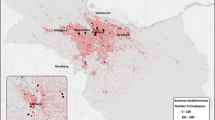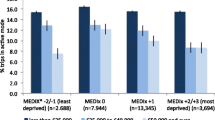Abstract
Most of the research on the influence of the built environment on travel has focused on reducing the impacts of travel, but one of the primary benefits of travel is the opportunity to engage in activities. This study examines a national travel data set to see if variation in the built environment can facilitate participation in out-of-the-home, nonwork activities for households. Although several studies have examined the relationship between the built environment and nonwork trip generation in the past, none have looked at such a wide range of built environments as a national data set can provide. Built environment variables are associated with higher than expected impacts on household participation in nonwork activities, increasing or decreasing activity levels in the range of 8–47 %, depending largely upon the level of household vehicle ownership. For households without vehicles, high residential and employment densities appear to support greater nonwork activity. Households with full access to vehicles appear to be supported by higher than average residential and employment densities and mid-range urban and metropolitan area sizes. Interestingly, activity participation in households with limited vehicle access is for the most part not affected by the built environment in a statistically significant way. In sum, these results suggest that the built environment may play a larger role in facilitating activity participation than previously presumed.

Similar content being viewed by others
Notes
I imputed income using ordered logistic regression, regressing income category against number of vehicles owned, number of workers in the household, home ownership, housing unit type, life cycle stage, and urban area size.
References
Bhat, C.R., Koppelman, F.S.: A retrospective and prospective survey of time-use research. Transportation 26(2), 119–139 (1999a)
Bhat, C.R., Koppelman, F.S.: Activity-based modeling of travel demand. In: Hall, R. (ed.) Handbook of Transportation Science. Kluwer Academic Publishers, Norwell (1999b)
Boarnet, M.G., Crane, R.: The influence of land use on travel behavior: specification and estimation strategies. Transp. Res. Part A Policy Pract. 35(9), 823–845 (2001)
Boarnet, M.G., Greenwald, M.J.: Land use, urban design, and nonwork travel. Transp. Res. Rec. 1772, 27–37 (1999)
Chapin, F.S.: Free time activities and quality of urban life. J. Am. Inst. Plan. 37(6), 411–417 (1971)
Crane, R., Crepeau, R.: Does neighborhood design influence travel: A behavioral analysis of travel diary and GIS data. Transp. Res. Part D 3(4), 507–527 (1998)
Ewing, R., Cervero, R.: Travel and the built environment: A synthesis. Transp. Res. Rec. 1780, 87–114 (2001). doi:10.3141/1780-10
Ewing, R., Cervero, R.: Travel and the built environment: A meta-analysis. J. Am. Plan. Assoc. 76(3), 265–294 (2010)
Ewing, R., Deanna, M., Li, S.C.: Land use impacts on trip generation rates. Transp. Res. Rec. 1518, 1–6 (1996)
Glaeser, E.L.: The Triumph of the City. Penguin Group, New York (2011)
Golob, T.F.: A simultaneous model of household activity participation and trip chain generation. Transp. Res. Part B: Methodol. 34(5), 355–376 (2000). doi:10.1016/s0191-2615(99)00028-4
Handy, S.L.: Understanding the link between urban form and nonwork travel behavior. J. Plan Educ. Res. 15(3), 183–198 (1996). doi:10.1177/0739456x9601500303
Hanson, S., Schwab, M.: Accessibility and intraurban travel. Environ. Plan B 19, 735–748 (1987)
Helling, A.: The effect of residential accessibility to employment on men’s and women’s travel. Paper presented at the FHWA, Women’s Travel Issues, Baltimore, 1996
Huntsinger, L., Rouphail, N.: Value of life cycle in explaining trip-making behavior and improving the temporal stability of trip generation models. Transp. Res. Rec. 2322, 60–69 (2012)
Imai, H.K., Keele, L., Yamamoto, T.: Identification, inference and sensitivity analysis for causal mediation effects. Stat. Sci. 25(1), 51–71 (2010)
Jacobs, J.: The Economy of Cities. Random House, New York (1969)
Kitamura, R., Akiyama, T., Yamamoto, T., Golob, T.F.: Accessibility in a metropolis: toward a better understanding of land use and travel. Transp. Res. Rec. 1780, 64–75 (2001).
Kitamura, R., Mokhtarian, P.L., Laidet, L.: A micro-analysis of land use and travel in five neighborhoods in the San Francisco Bay Area. Transportation 24(2), 125–158 (1997). doi:10.1023/a:1017959825565
Krizek, K.: Neighborhood services, trip purpose, and tour based travel. Transportation 30(4), 387–410 (2003)
Leake, G.R., Huzayyin, A.S.: Importance of accessibility measures in trip production models. Transp. Plan Technol. 6(1), 9–20 (1980). doi:10.1080/03081068008717170
Levine, J., Grengs, J., Shen, Q., Shen, Q.: Does accessibility require density or speed? J. Am. Plan Assoc. 78(2), 157–172 (2012)
Limanond, T., Niemeier, D.A.: Effect of land use on decisions of shopping tour generation: A case study of three traditional neighborhoods in WA. Transportation 31(2), 153–181 (2004)
Lin, J.J., Yang, A.T.: Structural analysis of how urban form impacts travel demand: Evidence from Taipei. Urban Stud 46(9), 1951–1967 (2009). doi:10.1177/0042098009106017
Meyer, M.D., Miller, E.J.: Urban Transportation Planning. McGraw Hill, Boston (2001)
Thill, J.C., Kim, M.: Trip making, induced travel demand, and accessibility. J. Geogr. Syst. 7(2), 229–248 (2005). doi:10.1007/s10109-005-0158-3
US Department of Transportation, FHWA, National Household Transportation Survey from http://nhts.ornl.gov (2009). Accessed 2 July 2012
US Department of Transportation, FHWA, 2009 National Household Transportation Survey User’s Guide. Retrieved from http://nhts.ornl.gov/publications.shtml (2012). Accessed 23 July 2012
Vosha, P., Petersen, E., Donnelly, R.: Model for allocation of maintenance activities to household members. Transp. Res. Rec. 1894, 170–179 (2004)
Zegras, C.: Mainstreaming sustainable Urban mobility. In: Dimitriou, H., Gakenheimer, R. (eds.) Urban Transport in the Developing World. Edward Elgar, Cheltenham (2011)
Acknowledgments
Thanks to Noreen McDonald and Daniel Rodriguez for detailed and insightful comments on an earlier version of this article. Thanks to my dissertation advisor, Yan Song, for continuous advice and support. Many thanks also to Qi Zhen and Professor Steve Marron for the idea of using cross-validation and insights on how to compare different model formulas. Also I appreciate the advice of Nikhil Kaza on how to approach the statistical analysis. Also, I have much gratitude to the Royster Society, without whose financial support I would not have been able to embark upon this research.
Author information
Authors and Affiliations
Corresponding author
Electronic supplementary material
Below is the link to the electronic supplementary material.
Rights and permissions
About this article
Cite this article
Merlin, L.A. Can the built environment influence nonwork activity participation? An analysis with national data. Transportation 42, 369–387 (2015). https://doi.org/10.1007/s11116-014-9554-1
Published:
Issue Date:
DOI: https://doi.org/10.1007/s11116-014-9554-1




